There's an exhibition of Artemisia Gentileschi on in Milan, but who wants to pay Milanese prices for a hotel? We're basing in Orta instead, with time for the holy statues.
You may not find this terribly rewarding unless you're included here, so this is a good time for casual and random browsers to turn back before they get too caught up in the sweep and majesty of the proceedings and can't let go.

After an early dash to the train line in Arona on Lago Maggiore, and an hour's ride to Milan Centrale, and a Metro ride to the Piazza del Duomo, we've just popped out of the tunnels like Caddyshack gophers for a look around.

And what do we see? The fourth largest cathedral in the world, and probably the most overdone Gothic edifice anywhere.

That's where we're headed, the Palazzo Reale across the square, but first: a look round the cathedral.

It's a hasty tour round the enormous interiors (we're anxious to go visit Artemisia), and we're not clambering up on the roof today.

That's the roof of the Duomo back in 1997, Marlowe and her dad. |

This revered gentleman has to sleep eternally under a metal faceplate, for which we are grateful. His old skull, however, is peeking out under the back of it.

St Bartholomew, holding his own skin after it had been removed inappropriately (grim statue by d'Agrate, 1562)
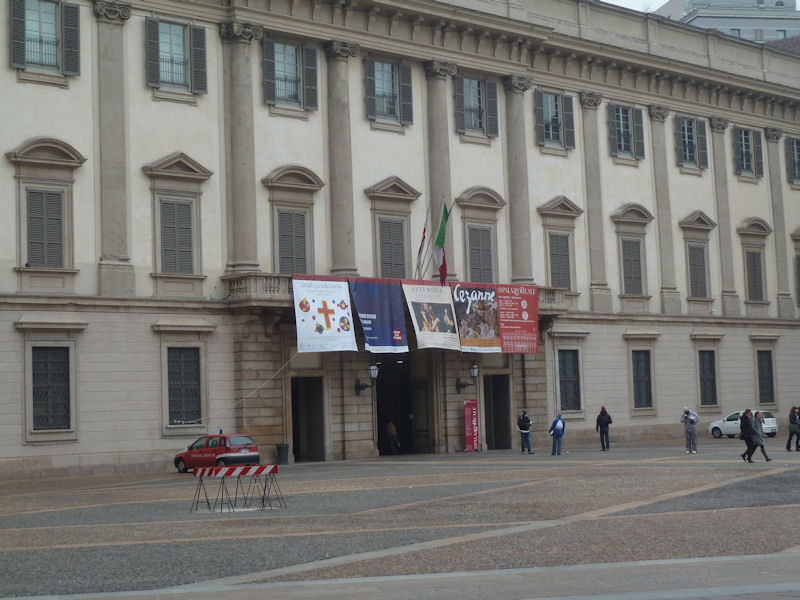
This is what we've come to Milan for, the Artemisia Gentileschi exhibition at the Royal Palace.

Artemisia (1593-1652 or so) was a brilliant early Baroque painter in what was largely a male's art industry -- born in Rome, she worked in Florence, back to Rome, Venice, Naples, London, and back to Naples, hugely successful, friends with Galileo, had her own studio of assistant artists, wonderful work.

The exhibition was great (but 'no photos'), some 50 works mostly by Artemisia, but including a few by her father and tutor Orazio and by contemporaries who influenced her development. Naturally, it played up the Avenging Heroine story more than was strictly necessary -- Artemisia was raped (more or less) at 17 years old, and (psychologists probably love this) throughout her long career she showed a fascination with scenes of horrific violence against men. Her most famous painting is likely this one above, Judith hacking the head off Holofernes (done when she was in her mid-20s, now in the Uffizi, and there's another that's now in the Capodimonte in Naples), which makes all other entries in the then-popular Judith-and-Holofernes genre look wimpy. Judging from her own self-portraits, Judith is even Artemisia herself. And seniors got a 2 euro reduction on the tickets.

Leaving the exhibition, observed from across the piazza by "Marella"

Pigeons in the piazza. Especially interesting are the third world gentlemen who, if you stop to observe the pigeons, race up and try to force pigeon-feed into your hand, exclaiming something like "beautiful pigeons" in one language after another.

The Duomo was begun in 1386 under Giangaleazzo Visconti and completed in 1805 when Napoleon Bonaparte, then in charge here, insisted that they finish the façade and promised to reimburse the expense of it, which he didn't.

We've moved on to the Castello Sforzesco, the old Visconti fortress enlarged by Francesco Sforza when he took over as Duke of Milano in the mid-15th century.

The main gate is noteworthy and requires to have your picture taken glumly in front of it.

The enormous outer courtyard

The Sforza Castle is filled with museums, and this one has got a special skinny Christ in faded Fruit-of-the-Looms.

Kristin suitably framed

Kristin's companion, surrounded by supplicant angels

The Thunderbolt of Italy -- Gaston de Foix hisownself, the brilliant French commander who marched through northern Italy in 1511-1512 capturing city after city, until having routed the Spanish army at the Battle of Ravenna, he got shot and died, at 23 years old.

-- You sinners! You Unbelievers! Up yours!

That's too much Castello Sforzesco for one day.

Kristin catching up on the news with the Isole di San Giulio lit up on the lake
Orta San Giulio

We wake to the Isole di San Giulio. A giant serpent used to live out there and terrorize everyone, but Saint Julius of Novara (a.k.a. Giulio di Orta), a 4th century missionary who was traveling in the region in order to destroy pagan altars, rowed out to the island on his cloak and terminated the nuisance with extreme prejudice.

One understands that Julius founded the Basilica of San Giulio on the island in 390, but the present church and tower date from the 11th and 12th centuries. There's evidently a convent out there now, and at least one hotel/restaurant, and a walking path round the circumference, but we didn't have a chance to take the public boat out there. A friend and I rowed around it in May 1992 but I was preoccupied with elevated thoughts and didn't bother to go ashore.

That's the Casa sul Lago as we're walking into town on a brisk, sunny day direct from heaven.

The coastal road into Orta San Giulio

Right through here -- delivery trucks just take their best chance.

We're hurrying along, because Kristin wants to get her hair cut. A nice lady, good haircut, about 0.04% of the price for the same in Switzerland.

The island from the Piazza Motta, the central square with all the public boat slips.

A rather meagre street fair on a bright Wednesday morning in late November; the weekly market was first documented here in 1228 and is probably more lively in the summer.

Another view of the Isole di San Giulio. Well, almost the same view.

Right on the Piazza Motta, a fairly well-abandoned hotel. Local people told us, a bit too eagerly, that it was being renovated and would reopen in a year or two. It certainly doesn't look like that.

The beautiful 16th century town hall

The island from the boat docks. The good ship "Pella" is named for the village directly across on the far side of the lake.

The ground floor of the Palazzo della Comunità

The main street of Orta San Giulio on the northern side of the Piazza Motta

We're wandering around on the one or two side streets

The village church of Santa Maria Assunta up the hill from the Piazza Motta

The island from the same spot

The Palazzo della Comunità and outdoor seating for the Hotel Venus
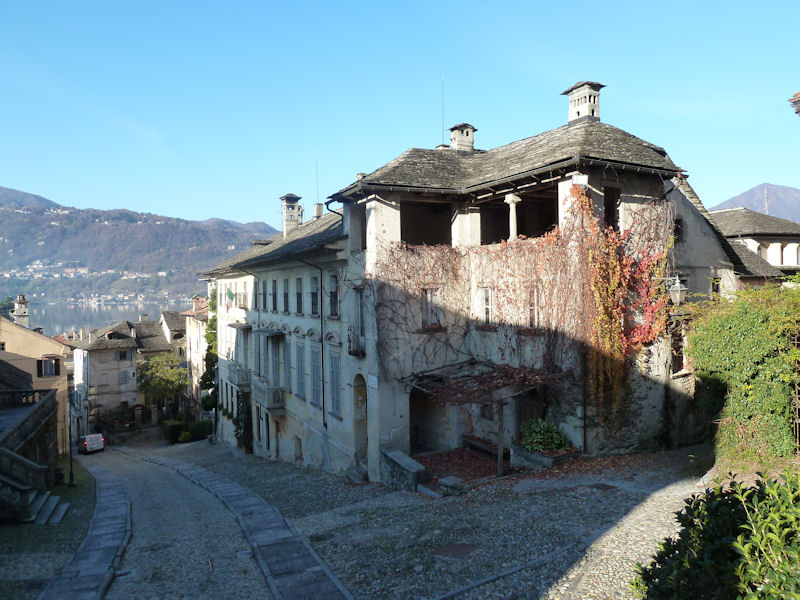
The Palazzo Penotti Ubertini (expositions, marriages, gala dinners, etc.)

The interior of Santa Maria Assunta

Well-merited, very big crowns (which may have made the Assunta part more difficult)

The view from the church door

Orta shoreline

The island again. This thing has so much history that there's no sense trying to summarize it, from Saint Julius' serpent, to the birth of William of Volpiano in 962 (architect of Mont-St-Michel and the Abbey of St-Germain-des-Prés) during Queen Willa's (the wife of King Berengarius II) holding out in the siege laid on by the Holy Roman Emperor Otto I ("the Great")(husband of Eadgyth of England), to the various revolts, century after century, against the Bishop of Novara.

The whole region around the lake, called the Riviera di San Giulio, was notoriously feisty, time after time over the years, but the HRE Frederick II ("Stupor Mundi") finally got things quietened down in 1219, and the area was owned by the Bishops of Novara until 1817, with a few secular interludes.

For example, at one point the Sforzas of Milan tried to annex the region and in 1524 sent along a mercenary army under a Visconti deadender named Anchises to sack the town and take hostages for ransom. In 1529 conditions got so bad that the town's population retreated to the Isole di San Giulio in open revolt. One thing led to another, and it appears that following a really nasty battle the Milanese were driven off and the Emperor Charles V recognized the rights of the lakeside villages to go back to living under the thumb of the Bishop of Novara.
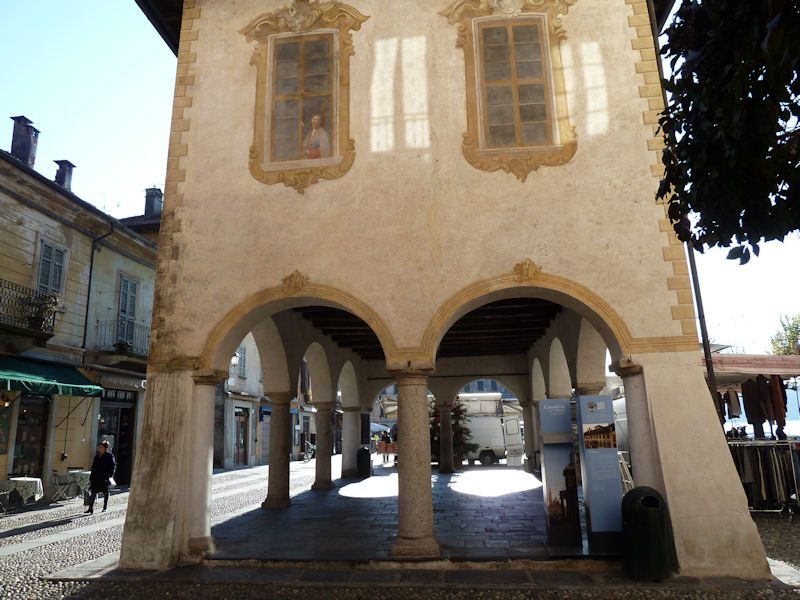
The town hall, with a trompe l'oeil lady preparing to scramble out the window and escape.

The Piazza Motta. A French army harassing a Spanish army in 1636 ran through the Lago di Orta region and burnt most of it to the ground, and in 1658 one of the Borromeos brought an army of German troops in with the same general result. In 1767 everyone had to swear allegiance to the King of Sardinia, but then luckily in 1817 the whole region was included in the Piedmont state owned by the King of Savoie.

Subsequently, everybody lived happily until the Nazis came.

The public boat taking an unhappy couple out to the island; they wanted to go out there for lunch and were dismayed when told that the restaurant was closed, but after some argument they went out anyway.
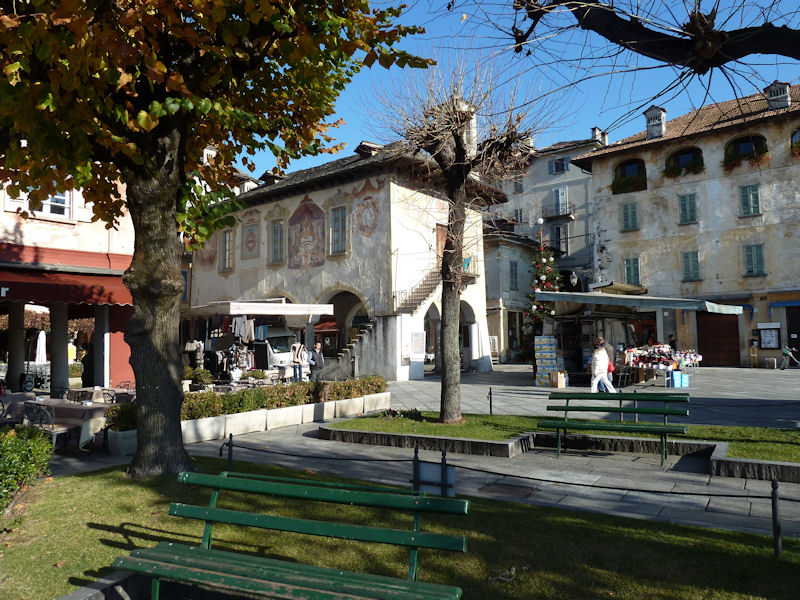
Piazza Motta. We've just had some real-life drama here, as one of the pierside fishermen hooked a seagull and all the men gathered round to advise on the best way to remove the hook. That ended happily.

The Isole and a war memorial on the main pier


My favorite restaurant in Orta -- Pizzeria La Campana, decent pizza, etc., and very good ambiance.

Isole di San Guilio

The bell tower

Close-up of the island; the elaborate buildings along the shore were evidently built by the canons of the church as suitable places for their private devotions.

The Casa sul Lago

From its "beach", or concrete picnic spot and lakeside. We're on our way home now.

But not before stocking up on Italian stuff in Domodossola at the Carrefour in the Simplon commercial centre.



A slimmer visit to the Venus restaurant in Orta San Giulio, 1992.
A few more photos of Milan in 1997.
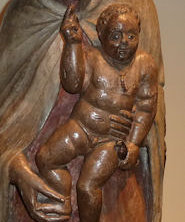 Dwight Peck's personal website
Dwight Peck's personal website






























































